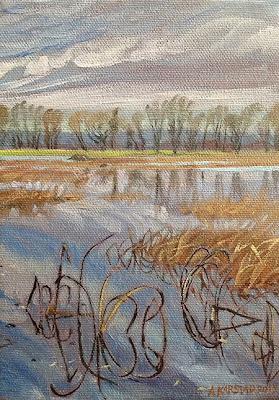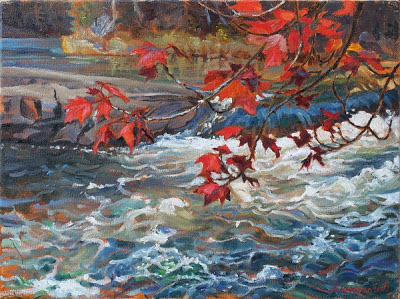Burreed Caligraphy (oil on canvas 5 x 7 in.)
5 November finds me painting on the south shore of the Ottawa River, at the end of a path from Francois du Pont Park, just west of Petrie Island. The thin curved leaves of Burr Reed draw calligraphic reflections on the water in a language unknown to me, but obvious to the river edge. As I sit painting, the meaning soaks in, elegant and clear. If the invasive European Reed, Phragmites australis were growing here, not only would it crowd out the native Burr reed, but the river would be entirely hidden from view except from higher up and farther back.
As Fred and Owen have been surveying these Ottawa River marshes for Unionids, they've been impressed by the dominance of Burreed (Sparganium). The haven't seen any Phragmites, invasive or native, and only a few patches of Cattails, usually the probably-alien Typha angustifolia. Nothing could be more superficially different than a Burreed's spherical fruit-head of protruding spikes, and a Cattail's stalk of compacted fluff. They both have buried rhizomes
which conduct air into the rooting zone, producing clusters of strap-like emergent leaves. Molecular studies conclude, without much excitement, that they're properly placed in the same family.
which conduct air into the rooting zone, producing clusters of strap-like emergent leaves. Molecular studies conclude, without much excitement, that they're properly placed in the same family.
I appreciate the quiet, intimate riverbank on this calm, overcast autumn evening. Its cloudy colours are so different now than the bright blue and yellow of the sunny afternoon. Somewhere along the shore to my left a Mallard emits a volley of laughing quacks, but otherwise all is quiet until I hear voices and the swish and clunk of a paddle. Fred pulls the canoe up onto the bank as Owen steps out with a bag of drift in hand.
They had found the water level to be 25 cm higher than normal, and only two fresh water mussels, both Elliptio complanata - one in a pile of plant material chewed up by Muskrats, and the other on a Beaver lodge. They had examined over 20 Muskrat mounds along the shore of a long, grassy barrier island of clay. There were lots of floating roots, stems and petioles of Burr Reed, Pickerel Reed and other plants disturbed by dabbling ducks and geese, dug up and strewn about by Beavers, and chopped up by Muskrats - it's a hard life, being an aquatic plant in the autumn.
Dear patrons and supporters,
This painting is for sale for $275 to support our work for conservation. If you would like to purchase it, please contact me




Comments
Post a Comment
What do you think of this painting, and what do you know about the subject that I have painted?